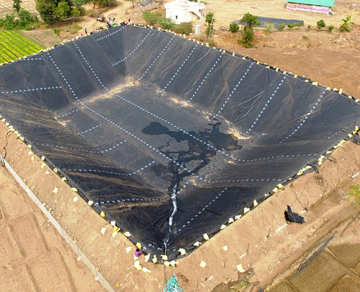Geomembranes have become indispensable in numerous industries due to their versatility and reliability. These synthetic materials, typically made from polymers, are widely used as liners and barriers in various applications. From water containment to waste management, geomembranes serve a critical role in ensuring that liquids and harmful substances do not seep into the surrounding environment. In this article, we’ll explore the primary uses of geomembrane pond liners and HDPE geomembrane liners across different sectors, emphasizing their importance in modern industry.
I.Water Containment and Ponds
One of the most common uses of geomembranes is in water containment systems, particularly for creating artificial ponds, reservoirs, and other water storage facilities. Geomembrane pond liners are an excellent solution for preventing water from leaking into the surrounding soil. This application is essential for various projects, including irrigation ponds, recreational lakes, and aquaculture.
By using geomembranes, industries can prevent water loss and ensure that valuable water resources are conserved. This is especially crucial in regions with sandy or porous soil where water retention is challenging. HDPE geomembrane liners are often chosen for their superior strength and resistance to environmental conditions, including UV radiation and extreme temperatures, making them ideal for long-term use in outdoor water storage systems.

II.Waste Management and Landfills
In waste management, geomembranes are crucial for lining landfills to prevent leachate—liquid produced by waste—from contaminating the surrounding soil and groundwater. HDPE geomembrane liners are commonly used in landfill sites because they offer strong chemical resistance, ensuring that toxic substances don’t escape into the environment. These liners are highly durable and provide a secure barrier between hazardous materials and the ecosystem.
In addition to their use in municipal landfills, geomembranes are also utilized in industrial waste containment. For example, hazardous waste facilities employ HDPE geomembrane liners to contain toxic chemicals, ensuring that they remain safely isolated from natural resources. The chemical resistance and impermeability of these liners make them an ideal solution for both short-term and long-term waste management projects.
III.Mining Industry and Heap Leaching
In the mining industry, geomembranes play an essential role in protecting the environment while facilitating mineral extraction. Heap leaching is a process in which a geomembrane is used to contain chemical solutions that extract valuable metals from ore. HDPE geomembrane liners are frequently used in this process due to their chemical resistance and durability.
By preventing these chemicals from leaking into the ground, geomembranes help mining companies maintain compliance with environmental regulations while increasing operational efficiency. Additionally, geomembranes are used to line tailings dams, where byproducts of mining are stored. This application ensures that harmful substances don’t escape into surrounding ecosystems, thus protecting both the environment and nearby communities.
IV.Agriculture and Irrigation
In the agricultural sector, geomembranes are used to create efficient irrigation systems. Geomembrane pond liners help store and manage water, especially in areas where water resources are scarce. Farmers rely on these liners to prevent water loss in irrigation ponds, canals, and reservoirs, ensuring that crops receive sufficient water during dry periods.
Moreover, geomembranes are also used to line irrigation channels, preventing water seepage and maximizing the amount of water available for agricultural use. The use of HDPE geomembrane liners in this context ensures long-term durability, reducing the need for frequent repairs or replacements. Their resistance to both chemicals and environmental conditions makes them a cost-effective solution for modern farming.
V.Environmental Protection
Environmental protection projects often employ geomembranes to prevent contamination of natural water sources and soil. For example, geomembrane pond liners are used in wetland restoration projects to maintain water levels and create ideal habitats for wildlife. The impermeability of these liners ensures that water remains within the designated area, helping to preserve delicate ecosystems.
In addition, HDPE geomembrane liners are used in stormwater retention systems and other environmental protection projects. These liners prevent pollutants from entering the groundwater, safeguarding water quality and protecting both human and environmental health. Their versatility allows them to be used in a variety of settings, from urban areas to natural reserves.

VI.Conclusion
In summary, geomembranes have become essential materials across numerous industries, offering reliable solutions for fluid containment and environmental protection. Whether used in water containment, waste management, mining, or agriculture, geomembrane pond liners and HDPE geomembrane liners provide unmatched durability, chemical resistance, and long-term performance. As industries continue to prioritize sustainability and efficiency, geomembranes will remain a critical component in many applications, ensuring that resources are protected and managed effectively.